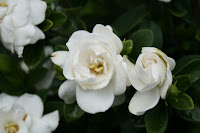Most shrubs flower during the warm seasons of the year, but those that bloom in the winter seem more precious because of the relatively rare occurrence of winter flowers.
First, evergreen foliage adds soothing green color to the winter landscape. This includes narrow leaf evergreens (conifers) that come in colors ranging from silver and blue to green to yellow and orange. It also includes broad leaf evergreens that are the special provenance of metro-Atlanta, and really contribute to the springtime feel of a landscape throughout the cold months.
Second, winter flowering shrubs have an excitement all their own, whether on deciduous or evergreen shrubs. The top three winter-flowering shrubs include
Witchhazel
Witchhazel is a medium to large deciduous shrub that particularly noted for winter flowers which appear on bare branches. There are dozens of varieties, hybrids and named cultivars of witchhazel in colors ranging from pale yellow, bright yellow, orange, red and rust. Those native to North America begin to bloom in the fall, while others bloom through March. Winter blooming, mildly fragrand flowers are each about an inch long with groups of narrow, ribbon-like, crinkly petals. Witchhazel has no serious insect or disease problems and is great for shrub borders, woodland gardens or as a specimen in a winter landscape.
Camellias
Camellias come in two main categories: Camellia sasanqua (familiarly known as “Sasanquas”) begin to flower on voting day in early November through December in metro-Atlanta, and Camellia japonica that bloom from late December through March. Lovely white, pink, red or variegated flowers, two to five inches across ornament the dark evergreen foliage of this popular and handsome, long-lived shrub.
Quince
Quince’s rose-like flowers burst forth on bare branches on the first warm days of winter. Shrubs come upright and rounded or low and spreading, and withstand both heavy clay and heat. Flowers come in shades of red, white, pink and orange. The variety with appleblossom pink, white, and pink-and-white flowers is called Toyo Nishiki
Crabapple LandscapExperts include winter flowering shrubs to enliven the season.













